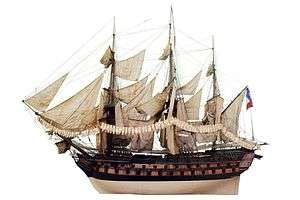HMS Pompee (1793)
 Scale model of Achille, sister ship of HMS Pompee (1793), on display at the Musée de la Marine in Paris. | |
| History | |
|---|---|
| Name: | La Pompée |
| Namesake: | Pompey |
| Builder: | Toulon shipyard |
| Laid down: | January 1790 |
| Launched: | 28 May 1791 |
| Commissioned: | February 1793 |
| Captured: | 29 August 1793 |
| Name: | HMS Pompee |
| Acquired: | 29 August 1793 |
| Reclassified: | Prison hulk in Portsmouth in 1816 |
| Fate: | Broken up in January 1817 |
| General characteristics | |
| Class and type: | Téméraire-class ship of the line |
| Tons burthen: | 1,9018⁄94 (bm) |
| Length: |
|
| Beam: | 49 ft 0 1⁄2 in (14.948 m) |
| Depth of hold: | 21 ft 10 1⁄2 in (6.668 m) |
| Sail plan: | Full rigged ship |
| Complement: | 640 |
| Armament: |
French service:
|
HMS Pompee was a 74-gun ship of the line of the British Royal Navy. Built as La Pompée, a Téméraire class ship of the French Navy, she was handed over to the British at Spithead by French royalists who had fled France[1] after the Siege of Toulon (September-December 1793) by the French Republic, only a few months after being completed. After reaching Great Britain, La Pompée was registered and recommissioned as HMS Pompee and spent the entirety of her active career with the Royal Navy until she was broken up in 1817.
Service
During the Siege of Toulon, Captain Poulain, her commanding officer, joined the British. La Pompée fled Toulon when the city fell to the French Republicans and sailed to Britain under the temporary command of Lieutenant John Davie. She arrived at Portsmouth on 3 May 1794, and was registered on the navy list under an Admiralty order dated 29 October 1794.[2]
She commissioned as HMS Pompee under her first commander, Captain Charles Edmund Nugent, in May 1795 and entered service with the Channel Fleet after a period of refitting. From August 1795 she was under Captain James Vashon, and she was later one of the ships involved in the Spithead mutiny in 1797.[2]
Leviathan, Pompee, Anson, Melpomene, and Childers shared in the proceeds of the capture on 10 September of the Tordenshiold.[3]
Under Captain Charles Stirling, she fought at the Battle of Algeciras Bay in 1801. In 1807 the ship, under the command of Captain Richard Dacres served in the Mediterranean squadron under Rear-Admiral Sir Sydney Smith,[4] as part of the Vice-Admiral Duckworth's Dardanelles Operation and later the Alexandria expedition of 1807.
In late 1808 Pompee was in the Caribbean, captured the brig Pylade on 20 October 1808. She shared with Captain, Amaranthe, and Morne Fortunee in the prize money pool of £772 3s 3d for the capture of Frederick on 30 December 1808. This money was paid in June 1829.[5]
Pompee participated in the capture of Martinique in January 1809. Later, she and Hautpoul took part in an action on 17 April 1809.
In April 1809, a strong French squadron arrived at the Îles des Saintes, south of Guadeloupe. There they were blockaded until 14 April, when a British force under Major-General Frederick Maitland and Captain Philip Beaver in Acasta, invaded and captured the islands.[6] Pompee was among the naval vessels that shared in the proceeds of the capture of the islands.[Note 1]
Fate
Pompee was fitted out for service as a prison hulk between September 1810 and January 1811.[2] She was finally broken up at Woolwich in January 1817.[2]
The acquisition of Pompée allowed the British to design a copy of the Téméraire class, the Pompée class.
Notes, citations, and references
The Portsmouth nickname "Pompey" may have its origins from HMS Pompee, which served as guard ship and prison hulk within Portsmouth Harbour, although there are several other coincidental and possible explanations for the "Pompey" nickname.
- Notes
- ↑ The prize agent for a number of the vessels involved, Henry Abbott, went bankrupt. In May 1835 there was a final payment of a dividend from his estate. A first-class share was worth 10s 2¾d; a sixth-class share, that of an ordinary seaman, was worth 1d. Seventh-class (landsmen) and eighth-class (boys) shares were fractions of a penny, too small to pay.[7]
- Citations
- ↑ http://www.godfreydykes.info/POMPEY_WHY_IS_IT_SO_CALLED.htm
- 1 2 3 4 Winfield. British Warships of the Age of Sail 1793–1817. p. 62.
- ↑ "No. 15704". The London Gazette. 22 May 1804. p. 652.
- ↑ pp.15-20, Howard
- ↑ "No. 18571". The London Gazette. 28 April 1829. p. 784.
- ↑ "No. 16262". The London Gazette. 30 May 1809. pp. 779–782.
- ↑ "No. 19255". The London Gazette. 3 April 1835. p. 643.
- References
- Howard, Edward, Memoires of Admiral Sir Sidney Smith, K.C. B., & c., Volume 2, Adamant Media Corporation, 2003
- Winfield, Rif (2007). British Warships in the Age of Sail 1793–1817: Design, Construction, Careers and Fates. London: Seaforth. ISBN 1-86176-246-1.